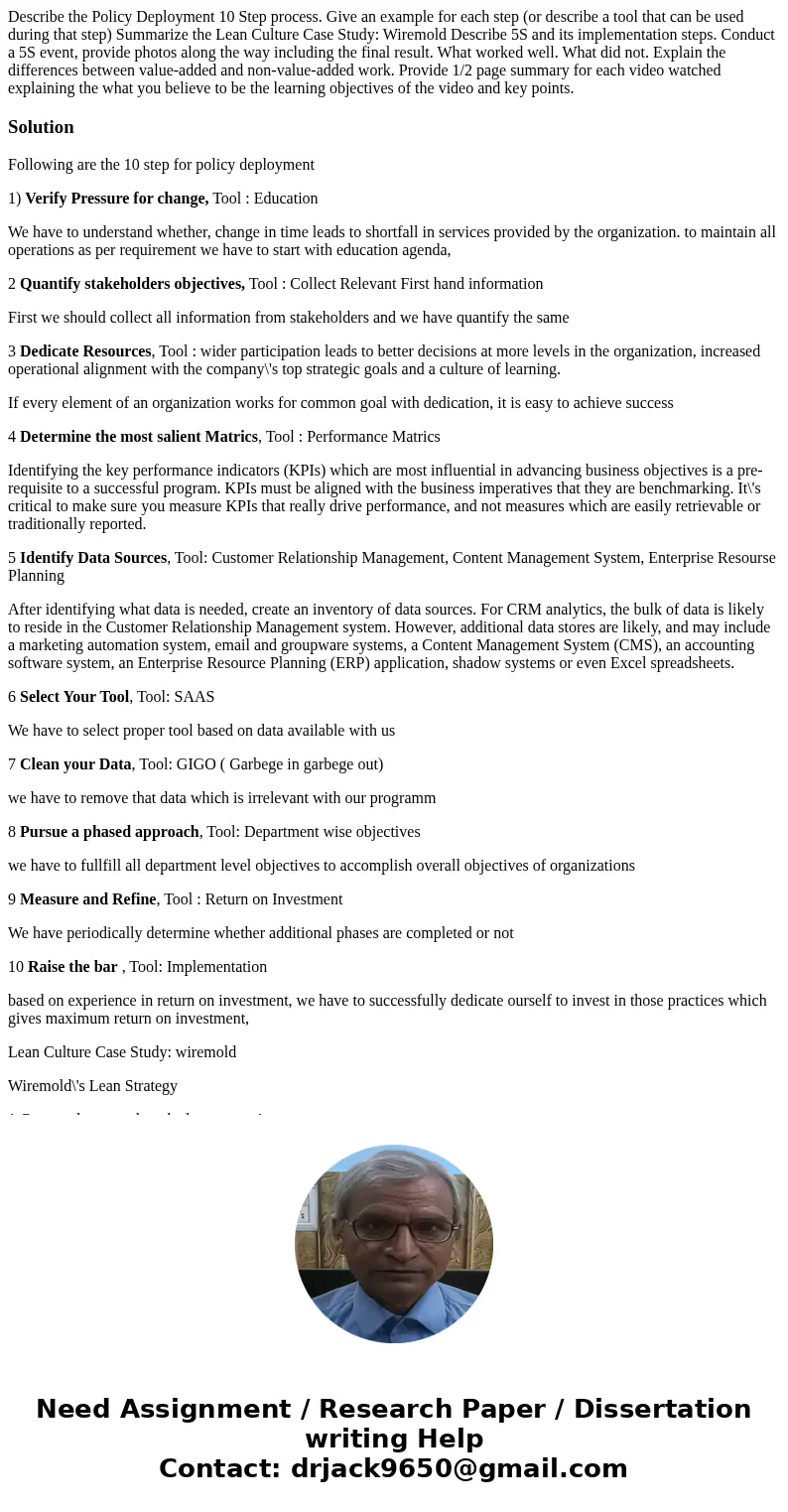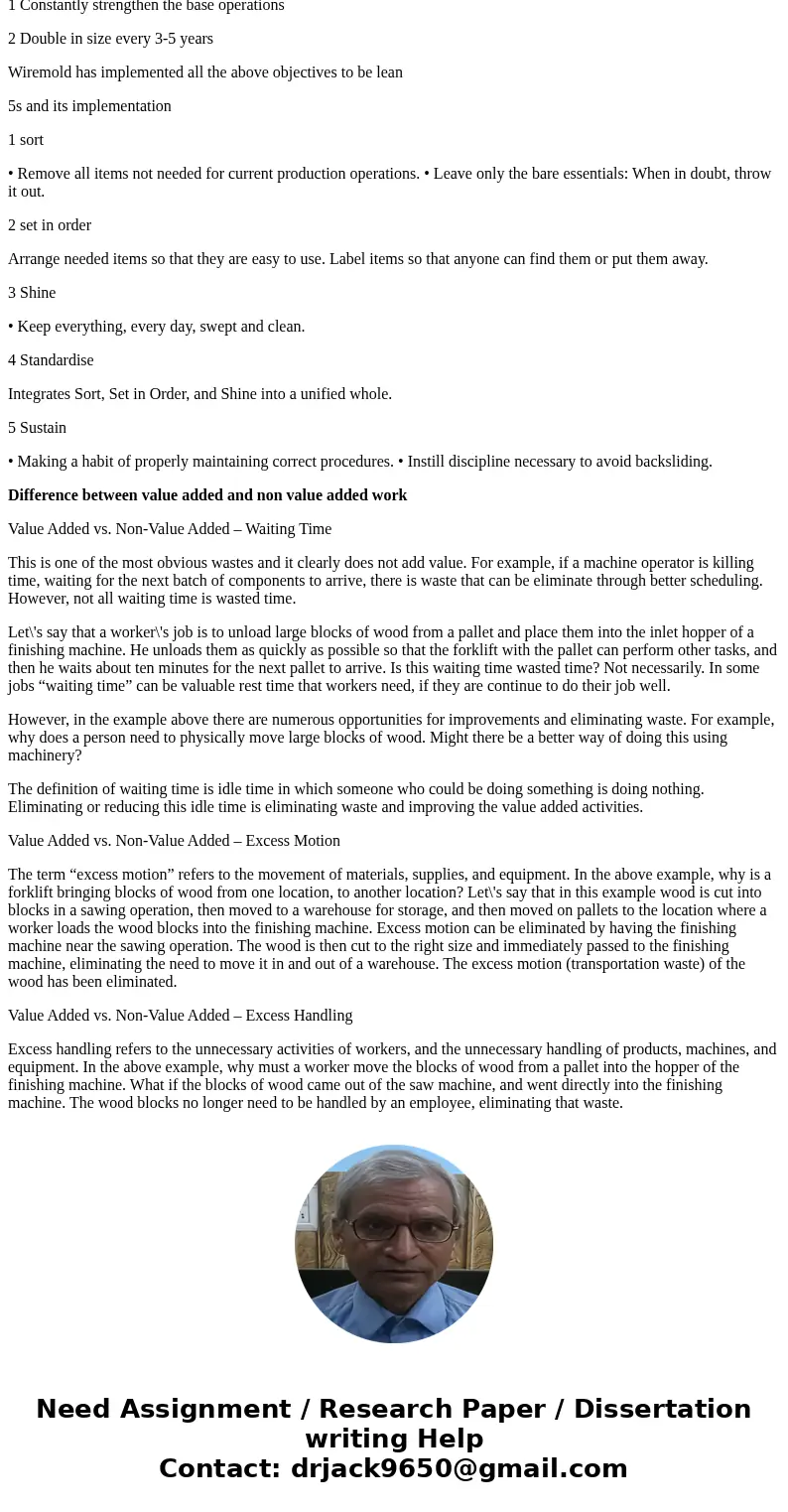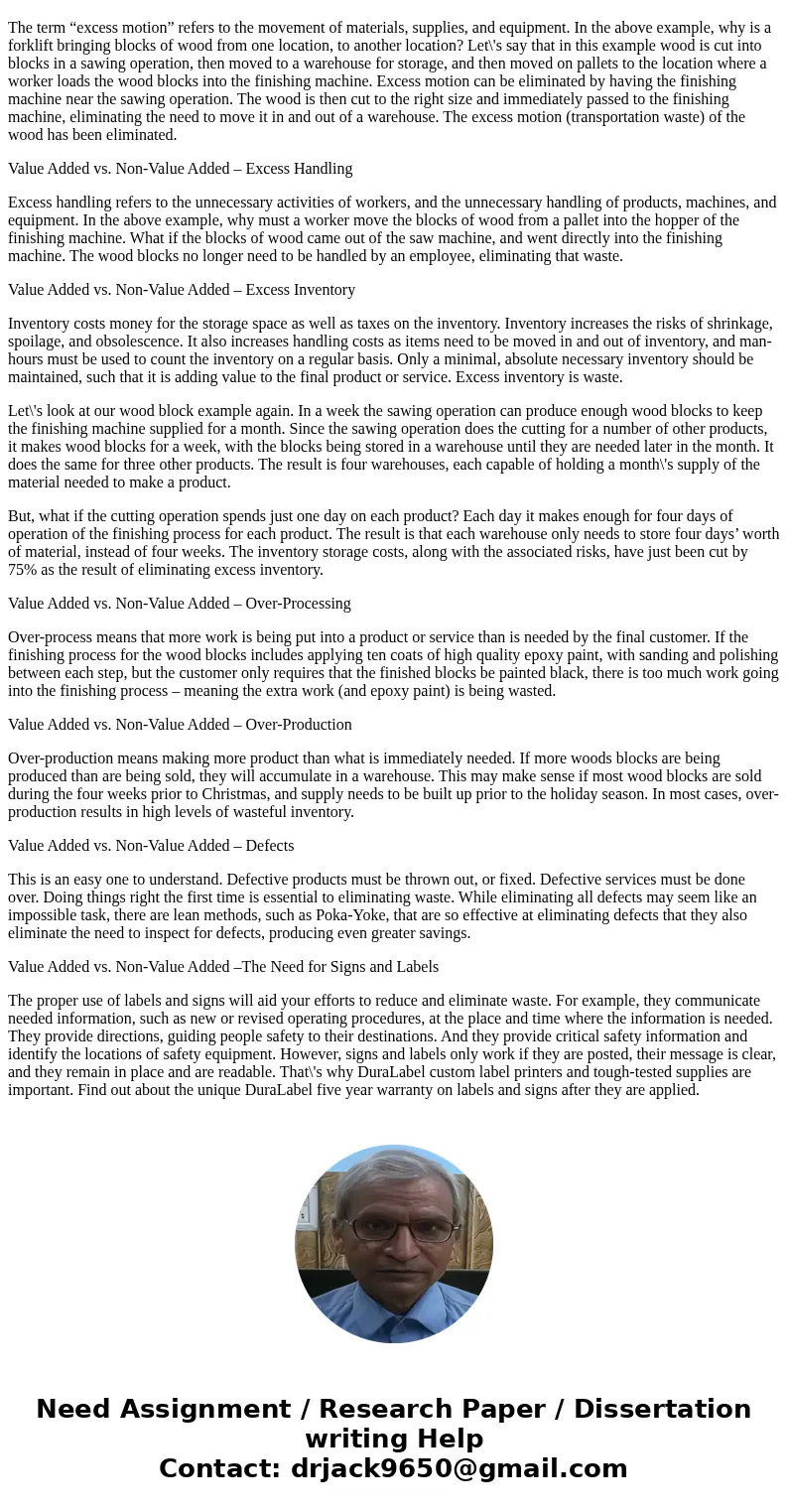Describe the Policy Deployment 10 Step process Give an examp
Solution
Following are the 10 step for policy deployment
1) Verify Pressure for change, Tool : Education
We have to understand whether, change in time leads to shortfall in services provided by the organization. to maintain all operations as per requirement we have to start with education agenda,
2 Quantify stakeholders objectives, Tool : Collect Relevant First hand information
First we should collect all information from stakeholders and we have quantify the same
3 Dedicate Resources, Tool : wider participation leads to better decisions at more levels in the organization, increased operational alignment with the company\'s top strategic goals and a culture of learning.
If every element of an organization works for common goal with dedication, it is easy to achieve success
4 Determine the most salient Matrics, Tool : Performance Matrics
Identifying the key performance indicators (KPIs) which are most influential in advancing business objectives is a pre-requisite to a successful program. KPIs must be aligned with the business imperatives that they are benchmarking. It\'s critical to make sure you measure KPIs that really drive performance, and not measures which are easily retrievable or traditionally reported.
5 Identify Data Sources, Tool: Customer Relationship Management, Content Management System, Enterprise Resourse Planning
After identifying what data is needed, create an inventory of data sources. For CRM analytics, the bulk of data is likely to reside in the Customer Relationship Management system. However, additional data stores are likely, and may include a marketing automation system, email and groupware systems, a Content Management System (CMS), an accounting software system, an Enterprise Resource Planning (ERP) application, shadow systems or even Excel spreadsheets.
6 Select Your Tool, Tool: SAAS
We have to select proper tool based on data available with us
7 Clean your Data, Tool: GIGO ( Garbege in garbege out)
we have to remove that data which is irrelevant with our programm
8 Pursue a phased approach, Tool: Department wise objectives
we have to fullfill all department level objectives to accomplish overall objectives of organizations
9 Measure and Refine, Tool : Return on Investment
We have periodically determine whether additional phases are completed or not
10 Raise the bar , Tool: Implementation
based on experience in return on investment, we have to successfully dedicate ourself to invest in those practices which gives maximum return on investment,
Lean Culture Case Study: wiremold
Wiremold\'s Lean Strategy
1 Constantly strengthen the base operations
2 Double in size every 3-5 years
Wiremold has implemented all the above objectives to be lean
5s and its implementation
1 sort
• Remove all items not needed for current production operations. • Leave only the bare essentials: When in doubt, throw it out.
2 set in order
Arrange needed items so that they are easy to use. Label items so that anyone can find them or put them away.
3 Shine
• Keep everything, every day, swept and clean.
4 Standardise
Integrates Sort, Set in Order, and Shine into a unified whole.
5 Sustain
• Making a habit of properly maintaining correct procedures. • Instill discipline necessary to avoid backsliding.
Difference between value added and non value added work
Value Added vs. Non-Value Added – Waiting Time
This is one of the most obvious wastes and it clearly does not add value. For example, if a machine operator is killing time, waiting for the next batch of components to arrive, there is waste that can be eliminate through better scheduling. However, not all waiting time is wasted time.
Let\'s say that a worker\'s job is to unload large blocks of wood from a pallet and place them into the inlet hopper of a finishing machine. He unloads them as quickly as possible so that the forklift with the pallet can perform other tasks, and then he waits about ten minutes for the next pallet to arrive. Is this waiting time wasted time? Not necessarily. In some jobs “waiting time” can be valuable rest time that workers need, if they are continue to do their job well.
However, in the example above there are numerous opportunities for improvements and eliminating waste. For example, why does a person need to physically move large blocks of wood. Might there be a better way of doing this using machinery?
The definition of waiting time is idle time in which someone who could be doing something is doing nothing. Eliminating or reducing this idle time is eliminating waste and improving the value added activities.
Value Added vs. Non-Value Added – Excess Motion
The term “excess motion” refers to the movement of materials, supplies, and equipment. In the above example, why is a forklift bringing blocks of wood from one location, to another location? Let\'s say that in this example wood is cut into blocks in a sawing operation, then moved to a warehouse for storage, and then moved on pallets to the location where a worker loads the wood blocks into the finishing machine. Excess motion can be eliminated by having the finishing machine near the sawing operation. The wood is then cut to the right size and immediately passed to the finishing machine, eliminating the need to move it in and out of a warehouse. The excess motion (transportation waste) of the wood has been eliminated.
Value Added vs. Non-Value Added – Excess Handling
Excess handling refers to the unnecessary activities of workers, and the unnecessary handling of products, machines, and equipment. In the above example, why must a worker move the blocks of wood from a pallet into the hopper of the finishing machine. What if the blocks of wood came out of the saw machine, and went directly into the finishing machine. The wood blocks no longer need to be handled by an employee, eliminating that waste.
Value Added vs. Non-Value Added – Excess Inventory
Inventory costs money for the storage space as well as taxes on the inventory. Inventory increases the risks of shrinkage, spoilage, and obsolescence. It also increases handling costs as items need to be moved in and out of inventory, and man-hours must be used to count the inventory on a regular basis. Only a minimal, absolute necessary inventory should be maintained, such that it is adding value to the final product or service. Excess inventory is waste.
Let\'s look at our wood block example again. In a week the sawing operation can produce enough wood blocks to keep the finishing machine supplied for a month. Since the sawing operation does the cutting for a number of other products, it makes wood blocks for a week, with the blocks being stored in a warehouse until they are needed later in the month. It does the same for three other products. The result is four warehouses, each capable of holding a month\'s supply of the material needed to make a product.
But, what if the cutting operation spends just one day on each product? Each day it makes enough for four days of operation of the finishing process for each product. The result is that each warehouse only needs to store four days’ worth of material, instead of four weeks. The inventory storage costs, along with the associated risks, have just been cut by 75% as the result of eliminating excess inventory.
Value Added vs. Non-Value Added – Over-Processing
Over-process means that more work is being put into a product or service than is needed by the final customer. If the finishing process for the wood blocks includes applying ten coats of high quality epoxy paint, with sanding and polishing between each step, but the customer only requires that the finished blocks be painted black, there is too much work going into the finishing process – meaning the extra work (and epoxy paint) is being wasted.
Value Added vs. Non-Value Added – Over-Production
Over-production means making more product than what is immediately needed. If more woods blocks are being produced than are being sold, they will accumulate in a warehouse. This may make sense if most wood blocks are sold during the four weeks prior to Christmas, and supply needs to be built up prior to the holiday season. In most cases, over-production results in high levels of wasteful inventory.
Value Added vs. Non-Value Added – Defects
This is an easy one to understand. Defective products must be thrown out, or fixed. Defective services must be done over. Doing things right the first time is essential to eliminating waste. While eliminating all defects may seem like an impossible task, there are lean methods, such as Poka-Yoke, that are so effective at eliminating defects that they also eliminate the need to inspect for defects, producing even greater savings.
Value Added vs. Non-Value Added –The Need for Signs and Labels
The proper use of labels and signs will aid your efforts to reduce and eliminate waste. For example, they communicate needed information, such as new or revised operating procedures, at the place and time where the information is needed. They provide directions, guiding people safety to their destinations. And they provide critical safety information and identify the locations of safety equipment. However, signs and labels only work if they are posted, their message is clear, and they remain in place and are readable. That\'s why DuraLabel custom label printers and tough-tested supplies are important. Find out about the unique DuraLabel five year warranty on labels and signs after they are applied.



 Homework Sourse
Homework Sourse